Human serum-derived hydroxy long-chain fatty acids exhibit anti-inflammatory and anti-proliferative activity
- PMID: 21586136
- PMCID: PMC3108922
- DOI: 10.1186/1756-9966-30-59
Human serum-derived hydroxy long-chain fatty acids exhibit anti-inflammatory and anti-proliferative activity
Abstract
Background: Circulating levels of novel long-chain hydroxy fatty acids (called GTAs) were recently discovered in the serum of healthy subjects which were shown to be reduced in subjects with colorectal cancer (CRC), independent of tumor burden or disease stage. The levels of GTAs were subsequently observed to exhibit an inverse association with age in the general population. The current work investigates the biological activity of these fatty acids by evaluating the effects of enriched human serum extracts on cell growth and inflammation.
Methods: GTAs were extracted from commercially available bulk human serum and then chromatographically separated into enriched (GTA-positive) and depleted (GTA-negative) fractions. SW620, MCF7 and LPS stimulated RAW264.7 cells were treated with various concentrations of the GTA-positive and GTA-negative extracts, and the effects on cell growth and inflammation determined.
Results: Enriched fractions resulted in poly-ADP ribose polymerase (PARP) cleavage, suppression of NFκB, induction of IκBα, and reduction in NOS2 mRNA transcript levels. In RAW264.7 mouse macrophage cells, incubation with enriched fractions prior to treatment with LPS blocked the induction of several pro-inflammatory markers including nitric oxide, TNFα, IL-1β, NOS2 and COX2.
Conclusions: Our results show that human serum extracts enriched with endogenous long-chain hydroxy fatty acids possess anti-inflammatory and anti-proliferative activity. These findings support a hypothesis that the reduction of these metabolites with age may result in a compromised ability to defend against uncontrolled cell growth and inflammation, and could therefore represent a significant risk for the development of CRC.
© 2011 Ritchie et al; licensee BioMed Central Ltd.
Figures

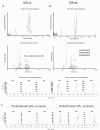
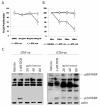


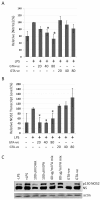
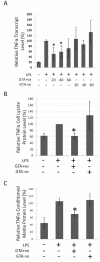
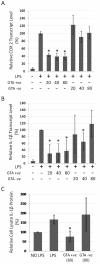
Similar articles
-
Anti-Inflammatory Effect of Asterias amurensis Fatty Acids through NF-κB and MAPK Pathways against LPS-Stimulated RAW264.7 Cells.J Microbiol Biotechnol. 2018 Oct 28;28(10):1635-1644. doi: 10.4014/jmb.1802.03044. J Microbiol Biotechnol. 2018. PMID: 30441883
-
Immune-Enhancement and Anti-Inflammatory Activities of Fatty Acids Extracted from Halocynthia aurantium Tunic in RAW264.7 Cells.Mar Drugs. 2018 Sep 1;16(9):309. doi: 10.3390/md16090309. Mar Drugs. 2018. PMID: 30200438 Free PMC article.
-
Two enone fatty acids isolated from Gracilaria verrucosa suppress the production of inflammatory mediators by down-regulating NF-kappaB and STAT1 activity in lipopolysaccharide-stimulated RAW 264.7 cells.Arch Pharm Res. 2009 Mar;32(3):453-62. doi: 10.1007/s12272-009-1320-0. Epub 2009 Apr 23. Arch Pharm Res. 2009. PMID: 19387591
-
Anti-proliferative and antioxidant properties of rosemary Rosmarinus officinalis.Oncol Rep. 2007 Jun;17(6):1525-31. Oncol Rep. 2007. PMID: 17487414
-
PARP inhibitors: new tools to protect from inflammation.Biochem Pharmacol. 2010 Dec 15;80(12):1869-77. doi: 10.1016/j.bcp.2010.04.022. Epub 2010 Apr 22. Biochem Pharmacol. 2010. PMID: 20417190 Review.
Cited by
-
Metabolic system alterations in pancreatic cancer patient serum: potential for early detection.BMC Cancer. 2013 Sep 12;13:416. doi: 10.1186/1471-2407-13-416. BMC Cancer. 2013. PMID: 24024929 Free PMC article.
-
Endogenous Anti-Inflammatory Very-Long-Chain Dicarboxylic Acids: Potential Chemopreventive Lipids.Metabolites. 2018 Nov 3;8(4):76. doi: 10.3390/metabo8040076. Metabolites. 2018. PMID: 30400281 Free PMC article.
-
Evaluating Ultra-long-Chain Fatty Acids as Biomarkers of Colorectal Cancer Risk.Cancer Epidemiol Biomarkers Prev. 2016 Aug;25(8):1216-23. doi: 10.1158/1055-9965.EPI-16-0204. Epub 2016 Jun 2. Cancer Epidemiol Biomarkers Prev. 2016. PMID: 27257090 Free PMC article.
-
Inducing the "re-development state" of periodontal ligament cells via tuning macrophage mediated immune microenvironment.J Adv Res. 2024 Jun;60:233-248. doi: 10.1016/j.jare.2023.08.009. Epub 2023 Aug 18. J Adv Res. 2024. PMID: 37597747 Free PMC article.
-
Association between IL-4 -589C>T polymorphism and colorectal cancer risk.Tumour Biol. 2014 Mar;35(3):2675-9. doi: 10.1007/s13277-013-1352-4. Epub 2013 Nov 12. Tumour Biol. 2014. PMID: 24218339
References
-
- Demaria S, Pikarsky E, Karin M, Coussens LM, Chen YC, El-Omar EM, Trinchieri G, Dubinett SM, Mao JT, Szabo E, Krieg A, Weiner GJ, Fox BA, Coukos G, Wang E, Abraham RT, Carbone M, Lotze MT. Cancer and inflammation: promise for biologic therapy. J Immunother. 2010;33:335–351. doi: 10.1097/CJI.0b013e3181d32e74. - DOI - PMC - PubMed
MeSH terms
Substances
LinkOut - more resources
Full Text Sources
Other Literature Sources
Research Materials

